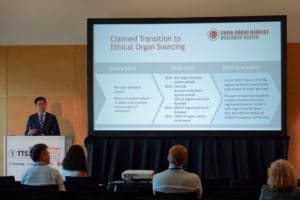New Report: Organ Transplant Abuse in China Continues Despite Claims of Reform

Co-author David Li introduces the latest developments in China's organ transplant and donation system at the report's release in Madrid, Spain. (PRNewsfoto/China Organ Harvest Research Ce)
Severe abuses continue in China’s organ transplant system—including the sourcing of organs from prisoners of conscience on a large scale—despite Chinese government assertions of reform, finds a new study by the China Organ Harvest Research Center.
The report was released at the 27th International Congress of The Transplantation Society, a biennial gathering of transplant experts from around the world.
“Chinese officials asserted that the donation framework was developed in just a few years, a process that took other countries decades,” the authors note. “Official accounts indicate that the percentage of organs sourced from donations jumped from 23% in 2013 to 80% in 2014, with voluntary donations becoming the sole official organ source in 2015. It is not plausible that such a complete transition in this system could have taken place in just one or two years.”
The report concludes that this disparity, together with other factors—including evidence of on-demand transplants and data falsification—means that many organs must be coming from elsewhere, including prisoners of conscience.

In preparing the 341-page report, researchers analyzed hundreds of transplant hospitals, government and industry statements, official policies and legislation, actual donation figures from various regions, the abuse of brain death criteria, and the broader operation of China’s donation and transplant system.
“The report highlights new evidence that has come to light since a June 2016 study by human rights lawyer David Matas, former Canadian Secretary of State for Asia-Pacific and Member of Parliament David Kilgour, and investigative journalist Ethan Gutmann,” says Dr. Huige Li, Professor at the University Medical Center of Mainz and co-author of the report.
The new report’s key findings include:
- Transplants outpace donations: The number of voluntary donations in China remains extremely low relative to the size of the transplant industry. At the end of 2017, the official count of registered donors was 373,536. If one applies the ratio of registered and actual donors in the United States to this total, such a donor base would have yielded fewer than 29 organ donors for transplants in China. The sum of reported donation numbers (mainly from non-registered donors in ICUs) in each region was also far fewer than the official figure of 15,000 transplants performed. Yet tens of thousands of transplants are performed in Chinese hospitals each year.
- On-demand transplants to foreigners continue: Official Chinese statements that no transplants are performed for foreigners have been discredited by recent investigations. In October 2017, journalists from a major Korean television station found that foreign patients from other parts of and the Middle East are still flocking to one of the largest transplant centers in China. Patients were quoted wait times of just days or weeks, with additional monetary “donations” to the hospital resulting in expedited surgeries.
- Regulation has not kept pace with claimed reform: China’s organ donation system and regulatory framework are still in their infancy and cannot support the number of transplants being performed in China and their on-demand nature. Agencies providing oversight for the donation system remain empty shells, and most organs used for transplants do not come from the national donation and allocation system presented to the international community.
- An alternate source of organs remains necessary: Because voluntary donations cannot support the number of transplants performed and experts acknowledge that criminal executions have shrunk in recent years, most of the organs must be coming from another source. Much evidence suggests that these organs are taken from prisoners of conscience in extrajudicial killings. The main source likely remains Falun Gong practitioners, who constitute the largest group of prisoners of conscience in China and have been systematically imprisoned, tortured, and forcibly subjected to blood tests and other medical examinations related to organ function, both in state custody and in their homes.
“China, as this outstanding, thorough and well-documented report shows, continues to permit abuses of human rights and the minimal ethical treatment of its citizens in permitting killing in order to obtain organs for transplant,” writes Professor Arthur L. Caplan, head of the division of medical ethics at New York University’s School of Medicine, in a preface to the report. “The report must be attended to by both the transplant community and governments all over the world.”
The report concludes that China’s purported reform has gained recognition by some international transplant organizations as a result of public relations campaigns, use of questionable data, aggressive roadmaps, transplant center showcases, and presentations at international forums.
“Our findings underscore the problem with taking the Chinese government’s claims of reform at face value. We hope it leads to a re-evaluation of how international institutions engage with Chinese transplant entities,” says Grace Yin, author and lead researcher of the study.

Given that China’s transplant system continues to be supported by the killing of innocents, the authors warn, “By expanding agreements to share organs with other parts of , Belt and Road regions, and beyond, the Chinese regime also risks implicating the international community in its crimes.”
The full report is available at: https://www.chinaorganharvest.org/app/uploads/2018/06/COHRC-2018-Report.pdf
The China Organ Harvest Research Center (COHRC) is a nonprofit organization that conducts and presents authoritative research on organ transplant abuse in China. Its researchers seek out and analyze evidence from a wide range of Chinese and overseas sources. Before establishing this organization in 2017, its lead researchers had studied the Chinese organ transplantation system for over a decade and contributed to reports cited by CNN, The New York Times, PBS, The Globe and Mail, and The Times of London.
Source: https://www.chinaorganharvest.org via PRNewswire-USNewswire









